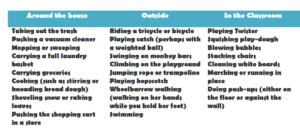
“Heavy Work” to parents, teachers and other caregivers of children with sensory processing difficulties. So what is heavy work? How does it work? How can it benefit your child? Read below to find out more!
Let’s start by talking about your senses. There are five, right? Actually, there are 8! In addition to the well-known ones of sight, smell, sound, taste and touch, there are also three less-known ones that are very important to sensory integration and occupational therapy. These “secret senses” are vestibular, proprioception and interoception. Today we will be talking more about proprioception and how we use this sense in therapy to help children with sensory processing difficulties improve their functioning. You may have heard these strategies referred to as “heavy work.”
Heavy work is a strategy used in therapy to target the sense of proprioception. Proprioception is responsible for helping our body understand where it is in space. For children with sensory processing difficulties, learning how to use the sense of proprioception to their advantage through heavy work activities can be especially powerful in helping them self-regulate, pay attention and remain calm in a variety of situations.
Heavy work is any activity that pushes or pulls on the body, more specifically our joints. The joints are where the receptors for proprioception are. When we participate in heavy work activities, messages are sent from receptors in our joints to receptors in our brainstem. These messages remind our brain and our body where we are in space and most importantly for many kids, make them feel safe! If our bodies and brains feel unsafe or unorganized, the higher parts of our brain’s cortex that control emotions, thinking, writing, attention, creativity and more, will not function as appropriately.
Heavy work is often seen as a great equalizer in terms of sensory integration
strategies. For children who are under-responsive, heavy work activities before
academic and fine motor tasks can help increase their alertness and attention to
task. While for children who are over-responsive, heavy work activities can help
them to calm down and decrease stress. So the moral of the story is… heavy work
can be good for everyone!
Heavy work can be incorporated into all parts of your child’s day. Common
heavy work activities include but are not limited to:
Visit https://drive.google.com/file/d/0B86bxhFxYKGzQ3NKZENLM19JVVU/view
for even more heavy work ideas!
If you have more questions about proprioception, heavy work, or any other
senses or therapy strategies please ask one of our Child’s Play OTs for more
information! Happy OT Month!
Bailey Rainey, OTR/L Huntsville



